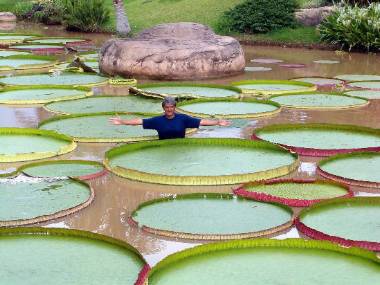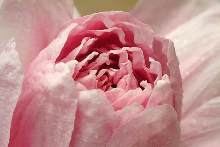We were first contacted by Luzmila Arroyo: I am botanist working at the Museum Noel Kempff Mercado in Santa Cruz, Bolivia, as an associated investigator. I am on the staff of the Missouri Botanical Garden here, doing inventories of plants. Bolivia is a beautiful country where you can see mountains and flat land in less than 100 km. Also in a few kilometers you can feel hot weather and cold weather. Bolivia is a mix of everything ... it is incredible! My friends Tonchi Ribero and José Ribero, owner and administrator of La Rinconada respectively, think they are growing unusually large Victorias. Can you tell us if this is so? Yes, this is so, we replied! The largest Victoria that we have ever found reported before was grown in 1891 at the United States Botanic Garden in Washington, D.C., by George W. Oliver. Its pads measured 90 inches (2.28 m) in diameter.
Ever Recorded!
I am Tonchi Ribero, a great admirer and lover of Victoria,
and the owner of La Rinconada, a garden restaurant near Santa
Cruz, Bolivia, where we proudly grow Victorias.
Our Victorias have grown incredibly large this year. The largest
one that we measured, December 27, 2005, was 2.78 m (109.4")
across. We measured again January 7, 2006, and though that largest
one had deteriorated, we had several pads of 2.70 m (106.3").
A group of photographers and botanical friends joined us to further
document the sizes January 10, 2006.
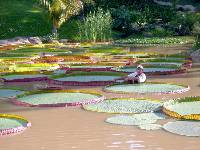
|
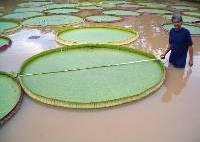
|
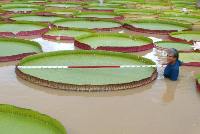
|
|
2.78 m (109.4") Luzmila Arroyo Photo |
2.67 m (105") José Ribero Photo |
2.70 m (106.3") José Ribero Photo |
 Zoomed ^ > >> |

|

|
The history of my Victorias is as follows:
Even though I am an engineer, my life is landscaping. About 22 years ago, I went to work in a garden in Santa Ana, Beni, which is in the northern part of Bolivia. The day of my arrival I was walking the city and, reaching it limits, I was amazed at my first sight of the Victorias. The strong individuality and the vibrant contrasting colors of the leaves, the beautiful and immense rosy flowers, made me think that I was dreaming.
 The lake at La Rinconada Roberto Vasquez Photo |
And the dream stayed with me, because at that moment I decided that sometime I was going to build a place where I could grow them. Six years ago I was able to build a small lake at La Rinconada, with the Victorias in mind. The soil in the bottom was water-proof reddish clay that, with the help of rain water and a water well 105 m (344.5') deep, maintains a relatively constant water level, which is 0.50 to 1.5 0m (20-59") deep. The water surface is protected from strong winds (which we have very often) by surrounding slopes and tropical vegetation. | |
|
Once the small lake was built, I sent one of my workers to Beni
and, since Santa Ana was too far north, I sent him to the nearest
place I had seen wild Victorias growing. This was a small river
branch about 33 km southwest of Trinidad (Beni) on the road to
San Ignacio de Moxos, 500 km north of Santa Cruz. This was in
September 2000. The natural pond had crystal clear water with
large Victorias in the center and small ones in the shallow ends. My worker came back with 26 small Victoria plants, wrapped in wet newspaper and plastic bags. Twenty out the 26 Victorias were placed in my small lake and the remaining 6 in a 500 liter tank. None of the 20 survived in the lake. I believed at the time that they rotted due to lack of light (the water is a muddy red because of bottom-feeding koi). |
 Map from OnlyMaps.com |
|
Out of the 6 plants in the tank, only 2 survived, which I transplanted later to the lake. Of the 2 only 1 survived making through the next winter, unlike all my following Victorias that all died in winter. The next season the one flowered a lot but only twice with 2 consecutive day flowers. The first time I pollinated them myself. The second time, I left the job to nature. *
After this, my first Victoria died in May 2002. Not knowing if the seeds would develop new plants, I sent my worker again in September of the same year to collect more plants in the same place that he did before. He brought 16, from which only one survived. To my joy, surrounding it were the first 27 Victoria plants that grew naturally from seed in the La Rinconada lake.
The following years, in 2003 I had 17 new plants and 11 for 2004. With this progression I thought I was destined to have almost none in 2005, but to my surprise almost 150 beautiful plants were born.
Myths and Misunderstanding About Victoria and Our Adventure With Victoria.
Water Gardeners International
WGI Journal Online Volume 1 Number 1
|
Water Gardening | Water Gardening Friends | New This Month Kit & Ben Knotts | Our Garden | Search The Site | Home Email Discussion List | Site Map Water Gardeners International |
